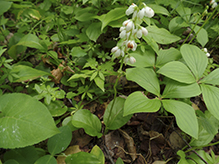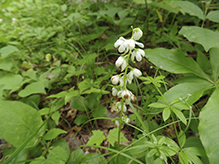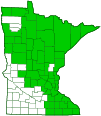shinleaf
(Pyrola elliptica)
Conservation • Wetland • Description • Habitat • Ecology • Use • Distribution • Taxonomy
Description |
Shinleaf, often called eliptic shinleaf, is a low growing, perennial forb that rises on a single stem from a horizontal underground stem (rhizome). It occurs across northern United States and southern Canada, and in Arizona and New Mexico. It is common in Minnesota. It grows in acidic, nutrient-poor, well-drained soil in moist areas of upland forests and woodlands. The stem is 4¼″ to 10½″ tall, erect, hairless and unbranched. The leaves are ½″ to 3″ long and 7 ⁄16″ to 2¼″ wide. They are alternate but are clustered at the base of the stem and appear almost basal. They are on ½″ to 1 9 ⁄16″ (12 to 40 mm) long leaf stalks (petioles). The petioles are hairless, channeled above, and as long or slightly shorter than the leaf blade. The leaf blades are broadly oval, widest in the middle and narrowing to both ends (elliptic), sometimes with nearly parallel sides (oblong). They are narrowly angled or tapered at the base and broadly pointed or rounded at the tip. The upper surface is dark green, shiny or dull, and hairless. The veins are not whitened. The lower surface is light green, dull, and hairless. The margins have tiny, inconspicuous teeth. The inflorescence is an unbranched cluster (raceme) of usually 3 to 14 flowers, sometimes up to 21 flowers. Each flower hangs downward on a hairless, ⅛″ to 5 ⁄16″ (3 to 8 mm) long flower stalk (pedicel). There is often no modified leaf (bract) at the base of the pedicel. Sometimes there are 1 or 2 bracts, rarely up to 4 bracts, subtending the pedicel. When present, the bracts are awl-shaped or narrowly lance-shaped and usually shorter than the pedicel that it subtends. The flowers are ¼″ to ⅓″ wide and broadly bell-shaped. There are 5 sepals, 5 petals, 10 stamens, and 1 style. The sepals are triangular, very short, and fused at the base. They are green or pinkish with thin, translucent (membranous) margins. The petals are white to greenish-white, inversely egg-shaped (widest at the tip), ¼″ to ⅜″ (6 to 10 mm) long, and ⅛″ to ¼″ (3 to 5.5 mm) wide. The stamens have white, ⅛″ to ¼″ (4 to 6 mm) long stalks (filaments) and orange anthers. The style is pale green, 3 ⁄16″ to ¼″ (5 to 7 mm) long, curved, and conspicuously protrudes below the corolla. The fruit is a flattened globe-shaped, ⅛″ to 3 ⁄16″ (3 to 5 mm) long, ⅛″ to ¼″ (3.3 to 6.6 mm) wide seed capsule. The sepals and style persist with the fruit. |
Height |
4¼″ to 10½″ |
Flower Color |
White |
Similar Species |
Habitat |
Dry. Upland forests and woodlands. Acidic, nutrient poor, well-drained soil. Dappled sunlight. |
Ecology |
Flowering |
June to August |
Pests and Diseases |
|
Use |
|
Distribution |
||
|
Sources |
|
| 6/3/2025 | ||
Nativity |
||
Native |
||
Occurrence |
||
Common and widespread |
||
Taxonomy |
|
Kingdom |
|
Division |
Tracheophyta (Vascular Plants) |
Subdivision |
Spermatophytina (Seed Plants) |
Class |
|
Order |
Ericales (heathers, balsams, primroses, and allies) |
Family |
Ericaceae (heath) |
Subfamily |
Pyroloideae/Monotropoideae |
Tribe |
Pyroleae |
Genus |
Pyrola (wintergreens) |
Subfamily Family |
|
Subordinate Taxa |
|
|
|
Synonyms |
|
Pyrola compacta Pyrola hybrida Pyrola maximowicziana Pyrola reticulata Pyrola rotundifolia Thelaia elliptica |
|
Common Names |
|
elliptic shin-leaf elliptic shinleaf large-leaved shineleaf shinleaf waxflower shinleaf wild lily-of-the-valley |
|
Glossary
Bract
Modified leaf at the base of a flower stalk, flower cluster, or inflorescence.
Filament
On plants: The thread-like stalk of a stamen which supports the anther. On Lepidoptera: One of a pair of long, thin, fleshy extensions extending from the thorax, and sometimes also from the abdomen, of a caterpillar.
Pedicel
On plants: the stalk of a single flower in a cluster of flowers. On insects: the second segment of the antennae. On Hymenoptera and Araneae: the narrow stalk connecting the thorax to the abdomen: the preferred term is petiole.
Petiole
On plants: The stalk of a leaf blade or a compound leaf that attaches it to the stem. On ants and wasps: The constricted first one or two segments of the rear part of the body.
Raceme
An unbranched, elongated inflorescence with stalked flowers. The flowers mature from the bottom up.
Rhizome
A horizontal, usually underground stem. It serves as a reproductive structure, producing roots below and shoots above at the nodes.
Sepal
An outer floral leaf, usually green but sometimes colored, at the base of a flower
Visitor Photos |
||
Share your photo of this plant. |
||
This button not working for you? |
||
Luciearl |
||
 |
 |
|
 |
 |
|
MinnesotaSeasons.com Photos |
||
 |
 |
|
Plant |
Plant |
|
 |
 |
|
Inflorescence |
Flower |
|
 |
||
Leaf |
|

Visitor Videos |
||
Share your video of this plant. |
||
This button not working for you? |
||
|
Other Videos |
||
MyNature Apps; Identifying Shinleaf, Pyrola elliptica |
About
Aug 5, 2011 How to identify Shinleaf, Pyrola elliptica also known as White Wintergreen. www.mynatureapps.com |

Created: 10/13/2019 Last Updated: © MinnesotaSeasons.com. All rights reserved. |




